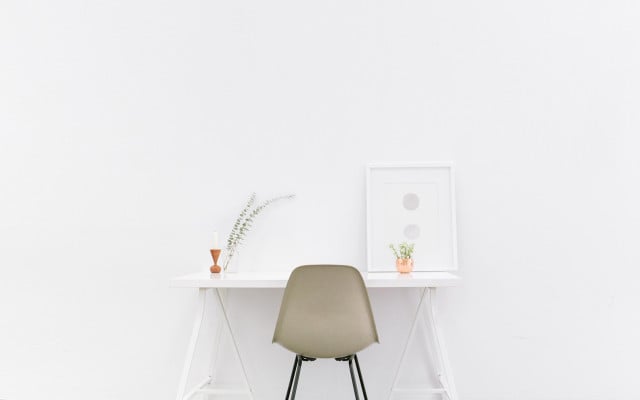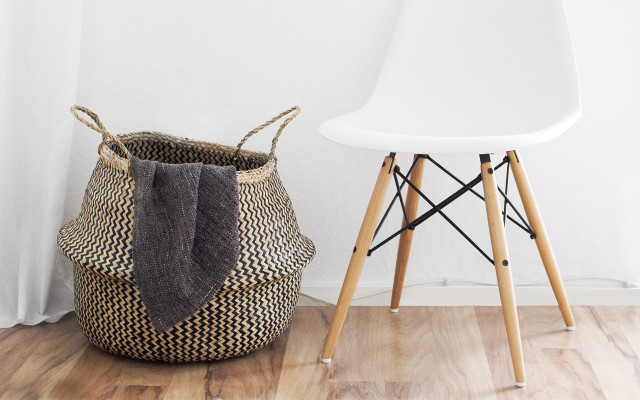Becoming minimalist means adopting a lifestyle of conscious relinquishment in order to make space for the essentials. But letting go of things isn’t always easy. These tips will help you become (more) minimalist in just a matter of weeks.
Becoming Minimalist: Less Is Happier
Getting rid of things is freeing – and feels nevertheless totally impossible. Too often we hold on to things that we don’t need, because we think that they could still be useful someday. Yet that rainy day rarely ever arrives. We’ve collected a few simple methods to help you cast aside that unnecessary baggage on your journey to becoming minimalist.
How radically you choose to apply these methods remains entirely up to you. Minimalist living should make you happier, so don’t stress too much.
Read on: How to Reduce Stress: 7 Ways to “Decelerate” Your Life

1. Eat that Frog: Do the Worst First
You’re not the only one who finds it difficult to get rid of stuff. This minimalist method should help you across the threshold of discarding possessions so that each additional sorting process in the future is that much easier.
So here’s one possible first step on your way to becoming minimalist: Pick at least one thing you love from among your possessions which you know you can live without. Don’t throw it away, but rather give it away or sell it. While this first experience may prove difficult, it underlines that while we love to possess many things, we only need very few things to make our lives truly happy. And in the future, it will be easier to separate the things you simply want from those you actually need.



2. The KonMari Method: Keep Only What Brings You Joy
Marie Kondo is a Japanese lifestyle expert and organizational guru. She advises her clients on organizing and discarding and rose to worldwide fame following her bestseller “The Life-Changing Magic of Tidying Up” – and her Netflix show “Tidying Up With Marie Kondo”, of course. Her method is easy to understand and implement and could just change your life, too.
In principle, she advises keeping only those possessions which bring us joy. That was, of course, the idea behind acquiring most of these things in the first place – to make us happier in some way.
Gather similar items together and then sort them at once: books with books, clothes with clothes. You touch each item individually and ask yourself whether it sparks joy. If yes, then keep it; if no, toss it. Minimalist organization can be as simple as that.
To start your journey to becoming minimalist, begin with less important items like pots and pans or cleaning implements, working your way up through clothes and books. Various mementos come at the very end, once you’ve acquired a thicker skin and better sense of where your joy lies. Most importantly, you always finish one category before starting on the next. Over time, your home is filled only with things that truly bring you joy.
Read on: Mindfulness Based Stress Reduction: Living in the Present



3. Becoming Minimalist with the Basket Method: the Anti-Shop
In this minimalist basket method, you grab a laundry basket, a large box, or some other similarly sized container. Then you proceed through your home and start poring over your things, much like you would at a clothing store.
In this basket, however, you place only items that you don’t like, that you don’t really need, and that are simply taking up valuable space in your home. Once the basket is full, you’ve reached your daily requirement. If you do this for an entire week, you’ll eliminate a lot of unnecessary stuff from your home – and you’re one step closer to becoming minimalist.
It’s easiest to begin in one room and then continue working your way through your home room by room. Depending on how large your home is and how much stuff you have, this can take a few weeks, but it is worth the effort in any case. Once you’ve got the first day of minimalist restructuring done, the rest will be a breeze.
Read on: Minimalist Wardrobe: Closet Clearing Tips and Tricks
Advanced-Level Minimalism: the Box Method
For this more radical minimalist method, you need moving boxes. The more things you have, the more boxes you need.
It goes like this: You pack everything you own into moving boxes. It’s best to sort everything carefully so that you can find things more easily when you need them. These boxes live alongside you in your home. Over a set period of time, you live only out of these boxes. Everything you need and get out of the boxes during that time can be replaced on a shelf or in a cupboard. Everything else is discarded.
Using this method, you quickly realize which things you actually want and need and which are unnecessary. Most of your possessions are easily forgotten once they’re packed away. This provides an easy way to figure out what can be eliminated.
Read more:
- Do I Even Need This?
- Plastic-Free Shopping: 3 Easy Tips for Waste Reduction
- 3 Simple Questions That Will Make You Quit Fast Fashion
This article was translated from German to English by Hilary. You can view the original here: Minimalismus: 3 Methoden für Einsteiger
** Links to retailers marked with ** or underlined orange are partially partner links: If you buy here, you actively support Utopia.org, because we will receive a small part of the sales proceeds. More info.Do you like this post?






